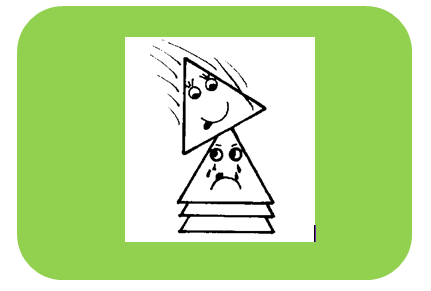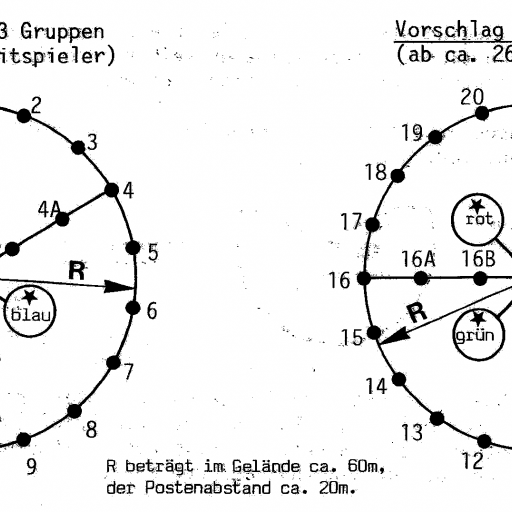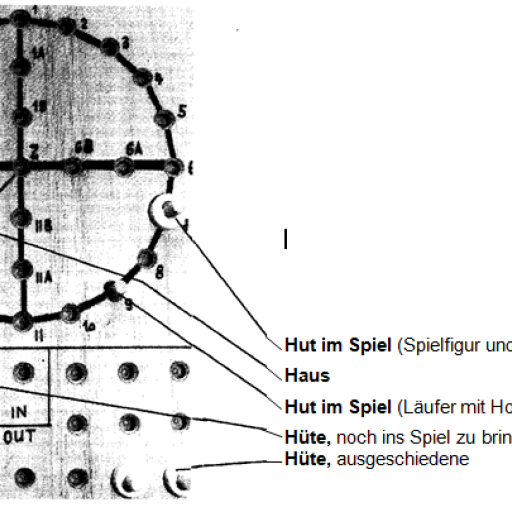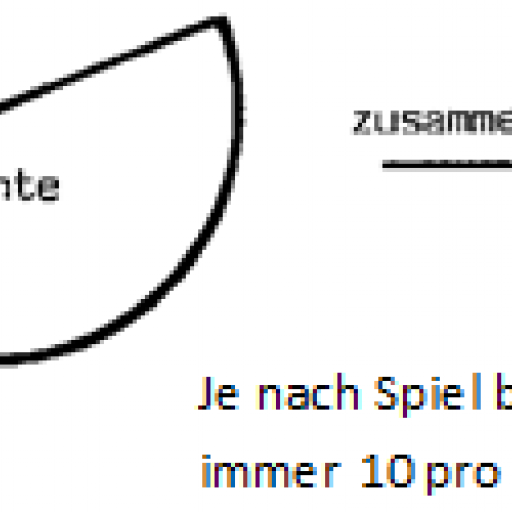Catch the hat - as an off-road game
+ Can be played during the day
+ No one needs to hide
+ No knocking off, capturing or similar
+ Speed and tactical action are required
+ Nothing works without cooperation in the group
- Elaborate game plans are required (but can be borrowed)
- Somewhat complicated set of rules
Surely you can put the game to good use in the next SOLA or on one of the upcoming afternoons. - The descriptions below are written in such a way that anyone can get into it. If you already know the board game, though, that makes it a lot easier.
1. Starting point and goal
Each group has 10 hats. The goal is to capture as many hats from the other groups as possible (see point 5 for rules of the game).
2. Terrain
Requires (if possible unsurveyable) forest, minimum size about 120 x 120 m.
3. Playground
In the forest, playing fields are marked as posts. Recommended are orienteering post tapes or A4 sheets fixed with pin-pins. They must also be numbered to avoid confusion.
The houses are located near the post Z=Center. The groups place themselves far enough apart so that they can play undisturbed.
4. The Game Plan
A game plan (e.g. made of wood) belongs to each "house". On it the game layout in the forest is shown. With game pieces (= wooden bolts) the location of players at the different posts is marked on it. A wooden ring belongs over each game piece. Since the production of 3 or 4 game plans is quite time-consuming, they can be borrowed (address at the end)
5. rules of the game / procedure
Starting point: Before the game begins, all players line up at their house. They organize themselves in their tasks. You need one referee per house, e.g. a leader. Each group gets 10 hats of their colour. They are made out of coloured neck cardboard.
>
Start:
Before the start, each group sends a first player with the first hat to any post. On the game board, he is marked with a figure accordingly. Arriving at the post, this player places the hat on his head in a clearly visible position. After the start, the dice are rolled clearly, e.g. with cups, and drawn on the game board. As long as there are hats in the house, the group is free to send a new hat into the field after each roll of the dice or to move a hat in the field. However, for each roll of the dice, a hat must be moved by the number rolled. From the house to the center or back it counts one eye rolled. There must always be at least 1 hat (more challenging is 2 or 3 hats) in the field. After the last one comes back, the next one must be in the field immediately.
Move hat
If a group decides to move Player A's hat in the field for a number rolled, the move is made on the game board. There are never two players on the same square. Then a fellow player B jumps away from the house to player A with the wooden ring and both run to the new post (control function). There player A hands the hat to player B and A comes back to the house with the wooden ring. In this way everyone comes back once again. From the start of player B until A comes back, i.e. as long as the wooden ring is on the way, this hat cannot be moved on the game board.
Until A is at B (touching), A can be grabbed.
Catch the hat
If the player of group I comes to a square already occupied by one of group II, player I wins all the hats his opponent is wearing on his head. He puts the won hats under his own. - There are no resting benches. The losing player then runs back to his house, informs his fellow players and removes the game piece from the game board. If it was the only hat on the way from Group II, immediately continue rolling the dice.
Hats into the house
The goal is to get as many enemy hats into your own house as possible. Coming back is only possible if it comes up with the number rolled. Thus, excess eyes do not expire. Once in the house, foreign hats are deposited and own hats can be brought back into the game. - A player may only return to the house if he has foreign hats.
Rolling the Dice
The individual groups roll the dice independently, i.e. any number of times and not in any particular order. The referee supervises that one hat is moved per roll. - The game automatically gains speed over time. If a player stays at the same post for a long time, he is more likely to be spotted and caught by others.
Winner
Once a group runs out of hats, the game is stopped. The winner is whoever has the most foreign hats in the house at that time.
Spies
Players without a task may spy around the forest and report the location of other players in the house. However, loud shouting is forbidden.
Material / Remarks (is on attached document = PDF file)
Source credits:
Car and images: Alex Meier, BESJ www.besj.ch
- Prisijunkite arba užsiregistruokite jei norite komentuoti
Turinys gali būti automatiškai išverstas. Padėkite pagerinti vertimo kokybę savo redagavimu!






